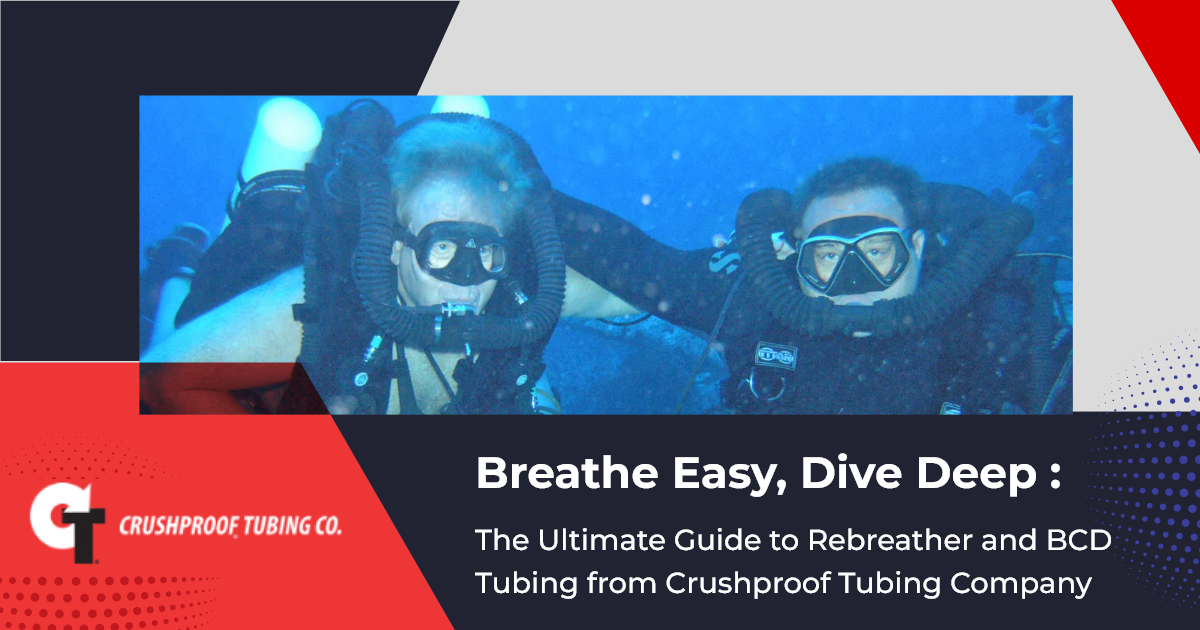Breathe Easy Underwater: The Complete Guide to Rebreather and BCD Tubing
Diving offers exciting views of underwater environments such as rivers, lakes, coral reefs, kelp forests, and quarries. To make it safe and exciting, critical equipment like rebreathers and buoyancy control devices (BCDs) are must-haves. Understanding these devices and the tubing involved is essential for any diver. This post introduces you to these devices, their benefits, and tips to choose the right BCD tubing for your application.
Overview of Rebreather and BCD
A rebreather is a sophisticated system that allows divers to stay underwater for several hours. It creates a closed-loop system by recycling the breathing gas exhaled by a diver. It scrubs carbon dioxide and adds oxygen to this recycled gas, allowing a diver to reuse exhaled air instead of venting it directly into the water. Unlike traditional open-circuit scuba systems, rebreather systems produce no bubbles that could startle wildlife, which makes them an ideal choice for underwater photography and videography.
A Buoyancy Control Device (BCD), also known as buoyancy compensator (BC), stabilizer, wing or adjustable buoyancy life jacket (ABLJ); helps divers maintain neutral buoyancy when diving in deep waters. These devices can be inflated or deflated to adjust buoyancy, which ensures a safe and more enjoyable diving experience by controlling your depth.
Benefits of Choosing Rebreather and BCD
Choosing a rebreather system and BCD for scuba diving has many benefits.
- Improved Dive Time: A rebreather recycles air and offers the optimal air mix for each depth. This allows for much longer dive times compared to traditional open circuit systems.
- Reduced Decompression Times: A rebreather system helps reduce decompression times by offering the best gas mix for different depths. This gas mix usually involves pure oxygen and other gases depending on the depths. A rebreather serves two purposes – replenishing the amount of oxygen exhaled by a diver and adding a mix of helium -oxygen and nitrogen-oxygen to balance the partial pressure of oxygen to keep the diver safe.
- Reduced Health Concerns: One major risk factor that divers experience is nitrogen narcosis, which is caused by breathing compressed nitrogen at depths beyond 100 feet. A rebreather system adjusts the gas mix to better match diving conditions, which can reduce the nitrogen absorption by the diver and subsequently the instances of nitrogen narcosis.
- Improved Buoyancy Control: BCDs offer precise control over buoyancy, which is important for a comfortable and safe diving experience.
Reduced Dehydration: Traditional scuba diving units deliver dry gas, which is the main cause of dehydration in divers. However, a rebreather system delivers warm, moist gas and reduces the risk of decompression sickness.
Why is Tubing Important in a Rebreather and BCD
Tubes play an essential role in the safety and functionality of rebreather and BCD systems.
- Hoses or tubing in a rebreather system carry the exhaled gas released by a diver to the scrubber system and then to the breathing oxygen loop after oxygen replenishment.
- Hoses or tubes ensure consistent air supply to BCD systems. BCD tubes allow divers to deflate or inflate BCD, which is essential to maintain neutral underwater buoyancy.
Tips for Choosing Rebreather and BCD Tubing
There are several things to consider while choosing the right rebreather and BCD tubing. The following pointers will help you make the right selection.
- The tubing must possess durable construction to withstand challenging environments underwater. It will be exposed to temperature and pressure changes and potential abrasion underwater.
- It must be kink-resistant, yet flexible to ensure uninterrupted airflow.
- The tubing must be compatible with your specific model of rebreather and BCD system and meet its requirements. Incorrect fittings may jeopardize the safety and performance of these systems.
- The hoses must be easy to clean and maintain. This is because proper care is essential for their performance, disinfection, and longevity.
Crushproof Tubing: Enhance your Diving Experience
Crushproof Tubing is a leading manufacturer of closed-circuit rebreather hose and BCD tubing. Our hoses stand out for the following reasons:
- We design the hoses that meet your specific requirements, not the other way around. We can provide them in custom lengths, diameters, and cuff options to meet your application requirements. Some common type of BCD and rebreather tubing offered by us is not limited to the following:
- Fixed length rebreather tubes
- Round BC tubes
- Oval BC tubes
- Stretchable rebreather tubes
- Our proprietary forming processes allow us to achieve 4:1 stretch ratios.
- This forming process also helps provide hoses in different rubber durometer options, spiral or annular convolution styles, and cuff sizes.
- The hoses can be designed to fit your exact specifications in different materials as well as UV and ozone-resistant properties.
- Our tubes can be cleaned and disinfected using heat, most common chemicals, or both.
As said before, choosing the right rebreather and BCD hose is essential for an exciting underwater experience. By partnering with Crushproof Tubing Company, you can be assured that you are getting the right design for your project. You can visit our Build-A-Hose page to get your free, custom sample, and see what you’ve been missing!


